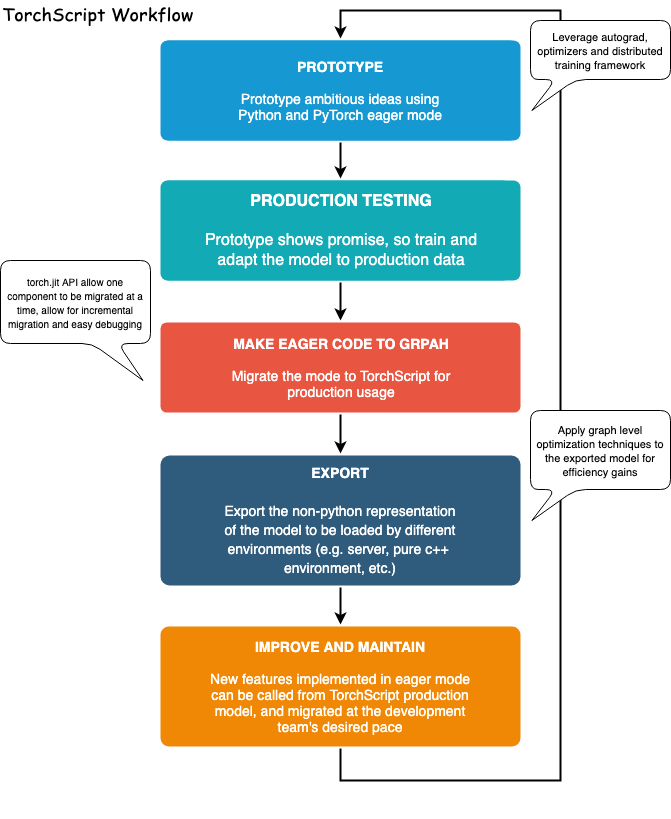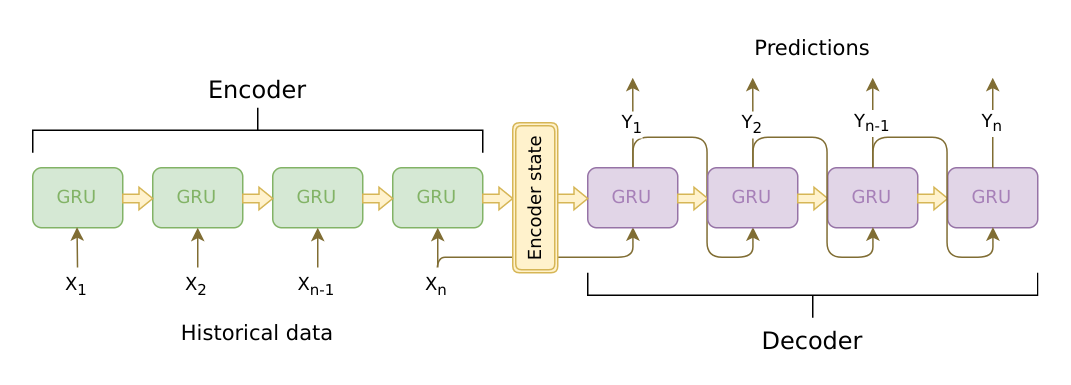使用TorchScript部署模型
Contact me
- Blog -> https://cugtyt.github.io/blog/index
- Email -> cugtyt@qq.com
- GitHub -> Cugtyt@GitHub
本系列博客主页及相关见此处
本文来自pytorch官网
什么是TorchScript
使用PyTorch的动态图(eager)模式可以很好的进行研究和开发,但是如果要部署的话,静态图更有利。而PyTorch提供了提供了把eager模式的代码转为TorchScript,它是静态分析和优化的Python子集,可以独立于Python运行时来表示深度学习项目。
TorchScript主要在torch.jit中,有两个核心模块:tracing和scripting,torch.jit.trace接受一个module或一个函数,以及一个样例输入,它就会调用这个模块或者函数,跟踪计算步骤,输出函数或者module的静态图。Tracing 可以很好的用于直接跟踪不依赖于数据的计算流程。但是如果函数依赖于数据,含有控制流,那么就会出现有的控制流不能被捕捉到,对于这种情况,需要使用scripting。他接受一个module或一个函数,但是不需要输入样例,它会把包括控制流的内容也转成TorchScript。需要注意的是scripting 只支持Python的子集,所以有时候可能需要重写代码来支持TorchScript。

下面是一个部署seq2seq的例子,详细内容见原链接:

from __future__ import absolute_import
from __future__ import division
from __future__ import print_function
from __future__ import unicode_literals
import torch
import torch.nn as nn
import torch.nn.functional as F
import re
import os
import unicodedata
import numpy as np
device = torch.device("cpu")
MAX_LENGTH = 10 # Maximum sentence length
# Default word tokens
PAD_token = 0 # Used for padding short sentences
SOS_token = 1 # Start-of-sentence token
EOS_token = 2 # End-of-sentence token
- 数据
class Voc:
def __init__(self, name):
self.name = name
self.trimmed = False
self.word2index = {}
self.word2count = {}
self.index2word = {PAD_token: "PAD", SOS_token: "SOS", EOS_token: "EOS"}
self.num_words = 3 # Count SOS, EOS, PAD
def addSentence(self, sentence):
for word in sentence.split(' '):
self.addWord(word)
def addWord(self, word):
if word not in self.word2index:
self.word2index[word] = self.num_words
self.word2count[word] = 1
self.index2word[self.num_words] = word
self.num_words += 1
else:
self.word2count[word] += 1
# Remove words below a certain count threshold
def trim(self, min_count):
if self.trimmed:
return
self.trimmed = True
keep_words = []
for k, v in self.word2count.items():
if v >= min_count:
keep_words.append(k)
print('keep_words {} / {} = {:.4f}'.format(
len(keep_words), len(self.word2index), len(keep_words) / len(self.word2index)
))
# Reinitialize dictionaries
self.word2index = {}
self.word2count = {}
self.index2word = {PAD_token: "PAD", SOS_token: "SOS", EOS_token: "EOS"}
self.num_words = 3 # Count default tokens
for word in keep_words:
self.addWord(word)
# Lowercase and remove non-letter characters
def normalizeString(s):
s = s.lower()
s = re.sub(r"([.!?])", r" \1", s)
s = re.sub(r"[^a-zA-Z.!?]+", r" ", s)
return s
# Takes string sentence, returns sentence of word indexes
def indexesFromSentence(voc, sentence):
return [voc.word2index[word] for word in sentence.split(' ')] + [EOS_token]
- 编码器
class EncoderRNN(nn.Module):
def __init__(self, hidden_size, embedding, n_layers=1, dropout=0):
super(EncoderRNN, self).__init__()
self.n_layers = n_layers
self.hidden_size = hidden_size
self.embedding = embedding
# Initialize GRU; the input_size and hidden_size params are both set to 'hidden_size'
# because our input size is a word embedding with number of features == hidden_size
self.gru = nn.GRU(hidden_size, hidden_size, n_layers,
dropout=(0 if n_layers == 1 else dropout), bidirectional=True)
def forward(self, input_seq, input_lengths, hidden=None):
# type: (Tensor, Tensor, Optional[Tensor]) -> Tuple[Tensor, Tensor]
# Convert word indexes to embeddings
embedded = self.embedding(input_seq)
# Pack padded batch of sequences for RNN module
packed = torch.nn.utils.rnn.pack_padded_sequence(embedded, input_lengths)
# Forward pass through GRU
outputs, hidden = self.gru(packed, hidden)
# Unpack padding
outputs, _ = torch.nn.utils.rnn.pad_packed_sequence(outputs)
# Sum bidirectional GRU outputs
outputs = outputs[:, :, :self.hidden_size] + outputs[:, : ,self.hidden_size:]
# Return output and final hidden state
return outputs, hidden
- 解码器
# Luong attention layer
class Attn(nn.Module):
def __init__(self, method, hidden_size):
super(Attn, self).__init__()
self.method = method
if self.method not in ['dot', 'general', 'concat']:
raise ValueError(self.method, "is not an appropriate attention method.")
self.hidden_size = hidden_size
if self.method == 'general':
self.attn = nn.Linear(self.hidden_size, hidden_size)
elif self.method == 'concat':
self.attn = nn.Linear(self.hidden_size * 2, hidden_size)
self.v = nn.Parameter(torch.FloatTensor(hidden_size))
def dot_score(self, hidden, encoder_output):
return torch.sum(hidden * encoder_output, dim=2)
def general_score(self, hidden, encoder_output):
energy = self.attn(encoder_output)
return torch.sum(hidden * energy, dim=2)
def concat_score(self, hidden, encoder_output):
energy = self.attn(torch.cat((hidden.expand(encoder_output.size(0), -1, -1), encoder_output), 2)).tanh()
return torch.sum(self.v * energy, dim=2)
def forward(self, hidden, encoder_outputs):
# Calculate the attention weights (energies) based on the given method
if self.method == 'general':
attn_energies = self.general_score(hidden, encoder_outputs)
elif self.method == 'concat':
attn_energies = self.concat_score(hidden, encoder_outputs)
elif self.method == 'dot':
attn_energies = self.dot_score(hidden, encoder_outputs)
# Transpose max_length and batch_size dimensions
attn_energies = attn_energies.t()
# Return the softmax normalized probability scores (with added dimension)
return F.softmax(attn_energies, dim=1).unsqueeze(1)
# TorchScript Notes:
# ~~~~~~~~~~~~~~~~~~~~~~
#
# Similarly to the ``EncoderRNN``, this module does not contain any
# data-dependent control flow. Therefore, we can once again use
# **tracing** to convert this model to TorchScript after it
# is initialized and its parameters are loaded.
#
class LuongAttnDecoderRNN(nn.Module):
def __init__(self, attn_model, embedding, hidden_size, output_size, n_layers=1, dropout=0.1):
super(LuongAttnDecoderRNN, self).__init__()
# Keep for reference
self.attn_model = attn_model
self.hidden_size = hidden_size
self.output_size = output_size
self.n_layers = n_layers
self.dropout = dropout
# Define layers
self.embedding = embedding
self.embedding_dropout = nn.Dropout(dropout)
self.gru = nn.GRU(hidden_size, hidden_size, n_layers, dropout=(0 if n_layers == 1 else dropout))
self.concat = nn.Linear(hidden_size * 2, hidden_size)
self.out = nn.Linear(hidden_size, output_size)
self.attn = Attn(attn_model, hidden_size)
def forward(self, input_step, last_hidden, encoder_outputs):
# Note: we run this one step (word) at a time
# Get embedding of current input word
embedded = self.embedding(input_step)
embedded = self.embedding_dropout(embedded)
# Forward through unidirectional GRU
rnn_output, hidden = self.gru(embedded, last_hidden)
# Calculate attention weights from the current GRU output
attn_weights = self.attn(rnn_output, encoder_outputs)
# Multiply attention weights to encoder outputs to get new "weighted sum" context vector
context = attn_weights.bmm(encoder_outputs.transpose(0, 1))
# Concatenate weighted context vector and GRU output using Luong eq. 5
rnn_output = rnn_output.squeeze(0)
context = context.squeeze(1)
concat_input = torch.cat((rnn_output, context), 1)
concat_output = torch.tanh(self.concat(concat_input))
# Predict next word using Luong eq. 6
output = self.out(concat_output)
output = F.softmax(output, dim=1)
# Return output and final hidden state
return output, hidden
- 考虑到根据[0, max_length)来迭代,因此需要scripting。

class GreedySearchDecoder(nn.Module):
def __init__(self, encoder, decoder, decoder_n_layers):
super(GreedySearchDecoder, self).__init__()
self.encoder = encoder
self.decoder = decoder
self._device = device
self._SOS_token = SOS_token
self._decoder_n_layers = decoder_n_layers
__constants__ = ['_device', '_SOS_token', '_decoder_n_layers']
def forward(self, input_seq : torch.Tensor, input_length : torch.Tensor, max_length : int):
# Forward input through encoder model
encoder_outputs, encoder_hidden = self.encoder(input_seq, input_length)
# Prepare encoder's final hidden layer to be first hidden input to the decoder
decoder_hidden = encoder_hidden[:self._decoder_n_layers]
# Initialize decoder input with SOS_token
decoder_input = torch.ones(1, 1, device=self._device, dtype=torch.long) * self._SOS_token
# Initialize tensors to append decoded words to
all_tokens = torch.zeros([0], device=self._device, dtype=torch.long)
all_scores = torch.zeros([0], device=self._device)
# Iteratively decode one word token at a time
for _ in range(max_length):
# Forward pass through decoder
decoder_output, decoder_hidden = self.decoder(decoder_input, decoder_hidden, encoder_outputs)
# Obtain most likely word token and its softmax score
decoder_scores, decoder_input = torch.max(decoder_output, dim=1)
# Record token and score
all_tokens = torch.cat((all_tokens, decoder_input), dim=0)
all_scores = torch.cat((all_scores, decoder_scores), dim=0)
# Prepare current token to be next decoder input (add a dimension)
decoder_input = torch.unsqueeze(decoder_input, 0)
# Return collections of word tokens and scores
return all_tokens, all_scores
- 验证
def evaluate(searcher, voc, sentence, max_length=MAX_LENGTH):
### Format input sentence as a batch
# words -> indexes
indexes_batch = [indexesFromSentence(voc, sentence)]
# Create lengths tensor
lengths = torch.tensor([len(indexes) for indexes in indexes_batch])
# Transpose dimensions of batch to match models' expectations
input_batch = torch.LongTensor(indexes_batch).transpose(0, 1)
# Use appropriate device
input_batch = input_batch.to(device)
lengths = lengths.to(device)
# Decode sentence with searcher
tokens, scores = searcher(input_batch, lengths, max_length)
# indexes -> words
decoded_words = [voc.index2word[token.item()] for token in tokens]
return decoded_words
# Evaluate inputs from user input (stdin)
def evaluateInput(searcher, voc):
input_sentence = ''
while(1):
try:
# Get input sentence
input_sentence = input('> ')
# Check if it is quit case
if input_sentence == 'q' or input_sentence == 'quit': break
# Normalize sentence
input_sentence = normalizeString(input_sentence)
# Evaluate sentence
output_words = evaluate(searcher, voc, input_sentence)
# Format and print response sentence
output_words[:] = [x for x in output_words if not (x == 'EOS' or x == 'PAD')]
print('Bot:', ' '.join(output_words))
except KeyError:
print("Error: Encountered unknown word.")
# Normalize input sentence and call evaluate()
def evaluateExample(sentence, searcher, voc):
print("> " + sentence)
# Normalize sentence
input_sentence = normalizeString(sentence)
# Evaluate sentence
output_words = evaluate(searcher, voc, input_sentence)
output_words[:] = [x for x in output_words if not (x == 'EOS' or x == 'PAD')]
print('Bot:', ' '.join(output_words))
- 加载预训练权重
save_dir = os.path.join("data", "save")
corpus_name = "cornell movie-dialogs corpus"
# Configure models
model_name = 'cb_model'
attn_model = 'dot'
#attn_model = 'general'
#attn_model = 'concat'
hidden_size = 500
encoder_n_layers = 2
decoder_n_layers = 2
dropout = 0.1
batch_size = 64
# If you're loading your own model
# Set checkpoint to load from
checkpoint_iter = 4000
# loadFilename = os.path.join(save_dir, model_name, corpus_name,
# '{}-{}_{}'.format(encoder_n_layers, decoder_n_layers, hidden_size),
# '{}_checkpoint.tar'.format(checkpoint_iter))
# If you're loading the hosted model
loadFilename = 'data/4000_checkpoint.tar'
# Load model
# Force CPU device options (to match tensors in this tutorial)
checkpoint = torch.load(loadFilename, map_location=torch.device('cpu'))
encoder_sd = checkpoint['en']
decoder_sd = checkpoint['de']
encoder_optimizer_sd = checkpoint['en_opt']
decoder_optimizer_sd = checkpoint['de_opt']
embedding_sd = checkpoint['embedding']
voc = Voc(corpus_name)
voc.__dict__ = checkpoint['voc_dict']
print('Building encoder and decoder ...')
# Initialize word embeddings
embedding = nn.Embedding(voc.num_words, hidden_size)
embedding.load_state_dict(embedding_sd)
# Initialize encoder & decoder models
encoder = EncoderRNN(hidden_size, embedding, encoder_n_layers, dropout)
decoder = LuongAttnDecoderRNN(attn_model, embedding, hidden_size, voc.num_words, decoder_n_layers, dropout)
# Load trained model params
encoder.load_state_dict(encoder_sd)
decoder.load_state_dict(decoder_sd)
# Use appropriate device
encoder = encoder.to(device)
decoder = decoder.to(device)
# Set dropout layers to eval mode
encoder.eval()
decoder.eval()
print('Models built and ready to go!')
- 转为TorchScript
### Compile the whole greedy search model to TorchScript model
# Create artificial inputs
test_seq = torch.LongTensor(MAX_LENGTH, 1).random_(0, voc.num_words).to(device)
test_seq_length = torch.LongTensor([test_seq.size()[0]]).to(device)
# Trace the model
traced_encoder = torch.jit.trace(encoder, (test_seq, test_seq_length))
### Convert decoder model
# Create and generate artificial inputs
test_encoder_outputs, test_encoder_hidden = traced_encoder(test_seq, test_seq_length)
test_decoder_hidden = test_encoder_hidden[:decoder.n_layers]
test_decoder_input = torch.LongTensor(1, 1).random_(0, voc.num_words)
# Trace the model
traced_decoder = torch.jit.trace(decoder, (test_decoder_input, test_decoder_hidden, test_encoder_outputs))
### Initialize searcher module by wrapping ``torch.jit.script`` call
scripted_searcher = torch.jit.script(GreedySearchDecoder(traced_encoder, traced_decoder, decoder.n_layers))
- 运行
# Use appropriate device
scripted_searcher.to(device)
# Set dropout layers to eval mode
scripted_searcher.eval()
# Evaluate examples
sentences = ["hello", "what's up?", "who are you?", "where am I?", "where are you from?"]
for s in sentences:
evaluateExample(s, scripted_searcher, voc)
# Evaluate your input
#evaluateInput(traced_encoder, traced_decoder, scripted_searcher, voc)
或参考简略例子